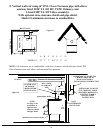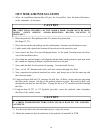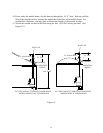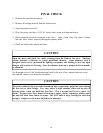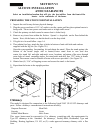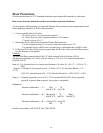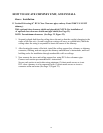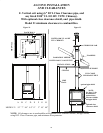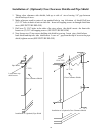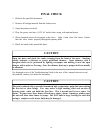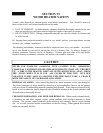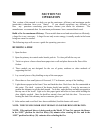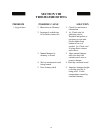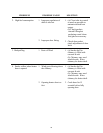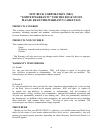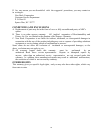
SECTION VI
WOOD HEATER SAFETY
Certain safety hazards are inherent in any wood heater installation. You should be aware of
these so that a safe and proper installation can be made.
1. FAULTY CHIMNEY: An older masonry chimney should be thoroughly checked to be sure
there are no holes or weak spots which could allow sparks or hot gases to escape.
2. HEAT CONDUCTION: Placing combustible materials too close to a heater or chimney can
be a fire hazard.
By keeping these particular hazards in mind as you install and use your room heater you can
ensure a safe, reliable installation.
The chimney and chimney connector should be inspected once every two months. Any build-
up of soot should be removed to prevent the risk of a chimney fire. To remove chimney or
chimney connector: Remove screws or fasteners. Remove pipe and clean with steel brush.
Replace chimney or chimney connector, and replace screws and/or fasteners.
CAUTION
NEVER USE GASOLINE, GASOLINE TYPE LANTERN FUEL, KEROSENE,
CHARCOAL LIGHTER FLUID OR SIMILAR LIQUIDS TO START OR "FRESHEN
UP" A FIRE IN THE HEATER. KEEP ALL SUCH LIQUIDS WELL AWAY FROM
THE STOVE WHEN IT IS IN USE. ALL FLUIDS OF THIS TYPE GIVE OFF
VOLATILE FUMES AND CAN AND WILL EXPLODE!! DON'T TAKE A CHANCE
WITH THE SAFETY OF YOUR HOME AND FAMILY.
DISPOSAL OF ASHES: Ashes should be placed in a metal container with a tight fitting lid.
The closed container of ashes should be placed on a non-combustible floor or on the ground,
well away from all combustible materials pending final disposal. If the ashes are disposed of by
burial in soil or otherwise locally dispersed, they should be retained in the closed container until
all cinders have thoroughly cooled.
CREOSOTE-FORMATION AND NEED FOR REMOVAL: When wood is burned slowly,
it produces tar and other organic vapors, which combine with expelled moisture to form
creosote. The creosote vapors condense in the relatively cool chimney flue of a slow-burning
fire. As a result, creosote residue accumulates on the flue lining. When ignited this creosote
makes an extremely hot fire.
35



